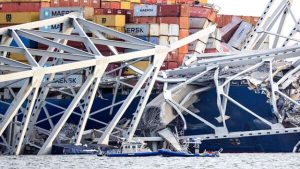 The crew of a cargo ship issued a “mayday” saying that they had lost power and propulsion before hitting the bridge, the authorities said, calling it an accident.
The crew of a cargo ship issued a “mayday” saying that they had lost power and propulsion before hitting the bridge, the authorities said, calling it an accident.
The dramatic video of the collapse of the Francis Scott Key Bridge in Baltimore will probably lodge itself in many people’s minds for a long time. But for engineers, seeing the footage might offer insight into why the span fell so quickly.
While it’s hard to know exactly what happened just from watching video, the impact of the major container ship on a key part of the bridge made the collapse of the bridge “pretty evident,” said Mark Richards, a structural engineer based in Britain who has worked in the field for 35 years. He was not involved in the construction of the Key Bridge.
When bridges are designed, Dr. Richards said, many scenarios — including risks and worst-case possibilities — are taken into account before the structures are built. Legislation also often requires that such possibilities are taken into account, he said.
Yet planning for any possible outcome is tough, he said.
“We can’t design every structure to accommodate every single possible event,” he said. But, he added, “these sorts of incidents are very, very, very rare.”
An investigation will have to show what went wrong, and which safeguards were in place to prevent such incidents. Other factors also have to be considered, he said, including the size and weight of the ship.
Sanjay R. Arwade, a professor of civil engineering at the University of Massachusetts Amherst, said that if the vessel had taken out one of the bridge’s two support piers, as it appeared to have done, a collapse would be almost inevitable.
“For any long-span bridge,” he said, “the complete loss of one of the piers is going to be catastrophic.”
Maryland officials said that rescue workers were searching for road repair crews who had been working on the Key Bridge when it collapsed early Tuesday and were plunged into the bay’s cold waters.
Paul J. Wiedefeld, Maryland’s transportation secretary, called the episode a “catastrophic collapse,” saying that “we know there were individuals on the bridge at the time” it was struck by a container ship around 1:30 a.m.
Among those who were on the bridge, according to Mr. Wiedefeld, were workers doing repair to the bridge’s concrete deck. He said it was unclear how many workers were part of the crew when the span fell.
Mr. Wiedefeld said that Baltimore’s port had suspended all ship traffic in and out of the harbor but that trucks were still being allowed to pick up shipments at the port for delivery along the East Coast.
The water where the bridge collapsed is about 50 feet deep, Mr. Wiedefeld told reporters. He said it was too early to say how many cars or people might still be in the water.
He also dismissed questions about the potential cause of the accident and whether the ship may have lost power.
“Too early,” he said.
The collapse of the Francis Scott Key Bridge has brought the Port of Baltimore, an important trade hub, to a halt.
The port handled a record amount of cargo last year, making it the 20th biggest port in the nation ranked by total tons, according to the Bureau of Transportation Statistics. It ranks first in the United States for the volume of automobiles and light trucks it handles and for vessels that carry wheeled cargo, including farm and construction machinery, according to a statement by Gov. Wes Moore of Maryland last month.
Around the world, about 40 ships, including 34 cargo vessels, have Baltimore listed as a destination, including 10 commercial ships with anchors dropped in nearby waters, according to MarineTraffic, which tracks ships.
Georgios Hatzimanolis, who analyzes global shipping for MarineTraffic, said he expects the bridge collapse to cause shipping delays. “We do expect there to be a ripple effect, but it’s a bit too early to say what the impact will be,” he said. Ships heading to Baltimore with cargo to unload may instead go to ports in New Jersey or North Carolina, he said.
The port has also increasingly catered to large container ships like the Dali, the 948-foot-long cargo vessel carrying goods for the shipping giant Maersk that hit a pillar of the bridge around 1:30 a.m. on Tuesday. The Dali had spent two days in Baltimore’s port before setting off toward the 1.6-mile Francis Scott Key Bridge.
The arrival of large container ships to the port “continues to demonstrate Baltimore’s capabilities of handling supersized vessels,” Governor Moore said in the statement. The largest container ship ever to enter the port, as of February, arrived last year with the capacity to carry more than 15,000 20-foot containers.
State-owned terminals, managed by the Maryland Port Administration, and privately owned terminals in Baltimore transported a record 52.3 million tons of foreign cargo in 2023, worth $80 billion. The port handled nearly 850,000 cars and light trucks last year, more than in any other U.S. port for the past 13 years.
Other materials transported in large volumes through the city’s port include coal, coffee and sugar. It was the ninth-busiest port in the nation last year for receiving foreign cargo, in terms of volume and value.
The bridge’s collapse will also disrupt cruises traveling in and out of Baltimore. Norwegian Cruise Line last year began a new fall and winter schedule calling at the Port of Baltimore.
